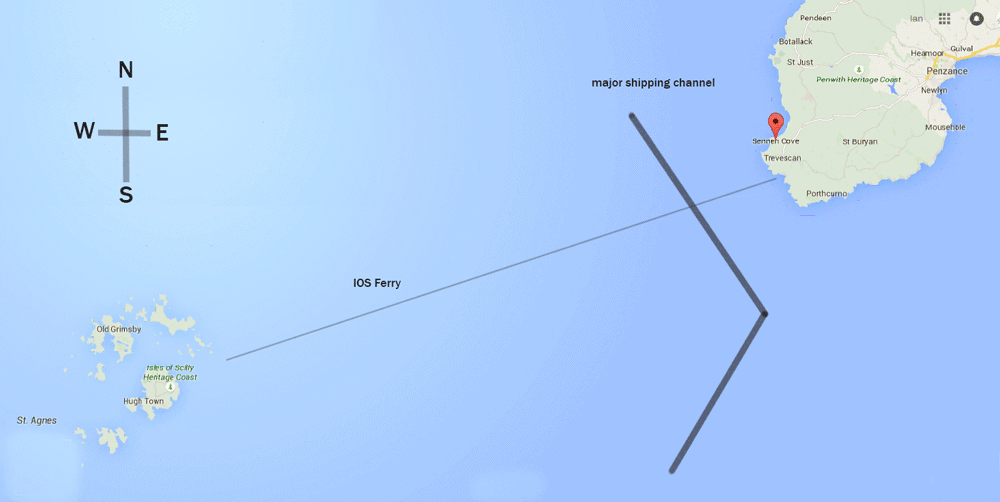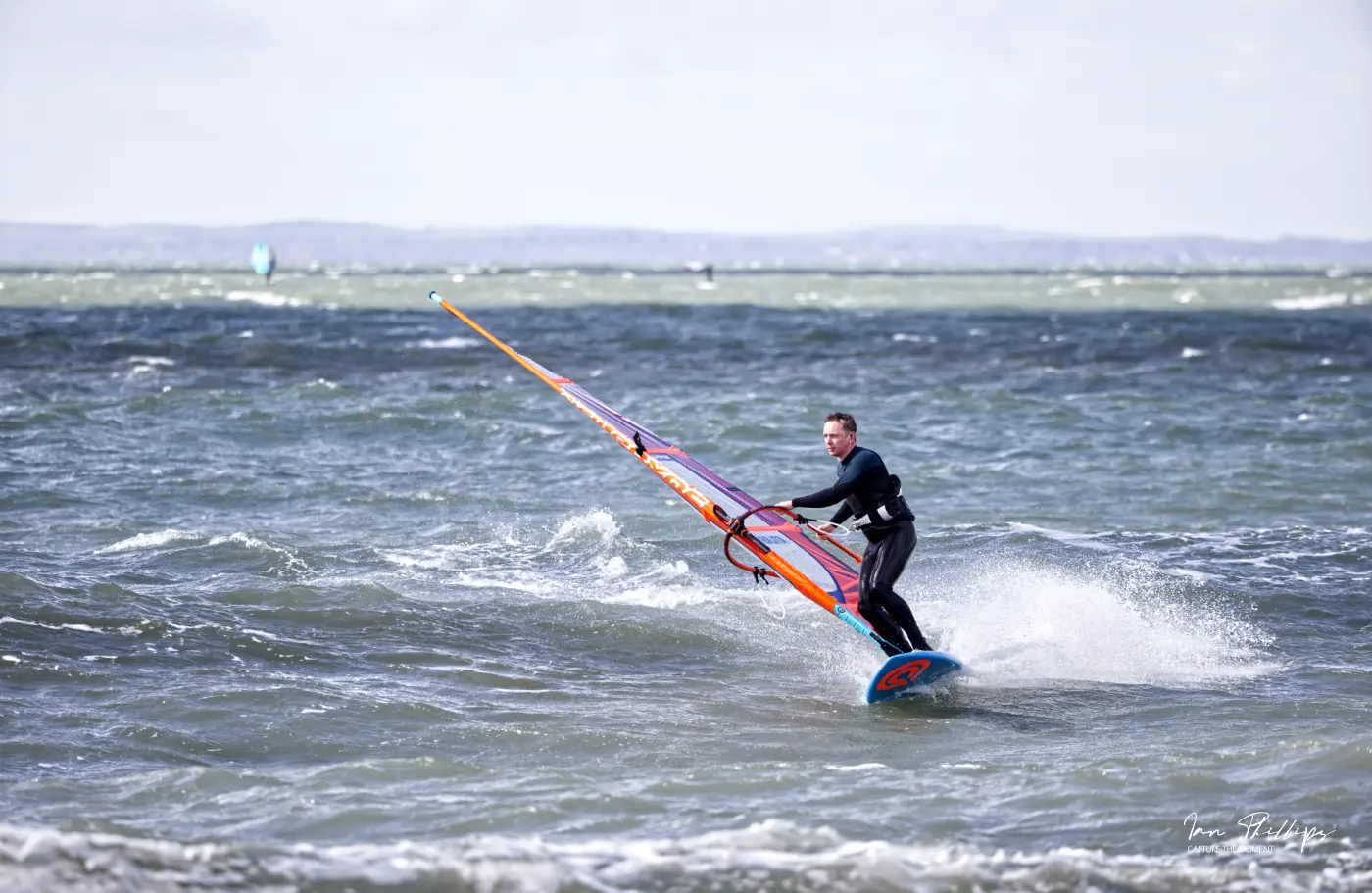One blind guy, a navigator, 2 inflatables, a winchman, a gardener and a software developer recently undertook a 50km across open sea with no support boat.
There was sun, laughs and plenty of banter but was it really a sensible undertaking. 8 hours on the water is a long time to be paddling for anyone, but think about being deprived of directional aids, clarity and land to put down on to relax those feet.
When we posted our expedition on Facebook we got loads of LIKES – https://www.facebook.com/pages/Jimmy-Lewis-Standup-paddleboards-UK-and-Ireland/476016455751338 – along with plenty of comments, but it got me thinking. Maybe this was not the best way to talk about our paddle as it made it all seem too easy. I don’t want anyone thinking this was just a little jolly across the water so I want to tell you exactly what was involved in planning and execution.
The Isles of Scilly is over 50km the Cornish Coast – this map shows its exact location.
You can see from the map that not only is this a big stretch of water but it also covers major shipping lanes, which pose a huge threat to the unwary. There are big tides, rips and lots of chances to get your landing wrong if you don’t get on top of your navigation.
A pre-trip think tank
Getting ready for this type of paddle requires a big understanding of the environment you’re going into, the skills required, nutrition and backup plans.
- Hydration and nutrition.
- Keeping supple is important and being able to stay stretched and relaxed at sea.
- Be able to use suitable communications equipment at sea, not just a mobile phone.
- A kit bag of spares.
- Emergency services protocols.
- Self rescue and team techniques.
- A communication method for your team.
- Kit choice.
- Selfies.
Hydration and nutrition
You are going to burn energy and lose fluid, not only from the paddling but from the constant stabilising of the board and sweating. Whilst I am not a nutrition expert, we had a good all round understanding of what it takes to maintain your body over this distance.
Camel back bags with extra skins are paramount. I think I used about 3 litres on my trip across. I had a mix of water with lemon juice and turmerick which is a great natural anti-inflamatory.
There are ready made gels out there but you don’t really want to overload on them so make sure you also have a water supply to keep yourself feeling cleansed inside as some of those gels/juices make me feel a bit sicky.
Sweets – not the best idea. The old method of a Mars bar simply supplies a quick fix of energy but then a crash so plan it more to offer a slow release of energy. I took small knuckle sized bags of trail mix containing nuts, blueberries etc. This delivers slow release energy and no come down, but you do end up a bit loose in the bowels department. And don’t forget bananas.
Understanding shipping lanes
Ships are big and fast. These big tankers can seem so slow at a distance, but as they approach you then appreciate just how fast they are really moving and how slow you are.
Common sense prevails with shipping lanes, but most importantly, don’t try and race the ships – you won’t win. Collect everyone together in your group and paddle across together. What you have to avoid with shipping is it remaining on a “steady bearing” with you when you are both moving. It means you will collide!! If it stays on 270 degrees or 11 o’clock for instance you need to change course to change the bearing so you pass astern.
Pre adventure training
We can’t all spend hours on the water, but a general good level of fitness is required. I am no longer the sports nut I once was but I do have a comfortable level of fitness that means I can sustain a good pace for a lengthy period.
What is just as important is to remain agile and being able to stretch when out on the water really helps. Increase your flexibility and spend time paddling in rough water. Become comfortable with handling yourself when water gets ugly.
Also practice surfing your big board so if push comes to a shove you can ride the swells and keep travelling. Oh yeah, practice paddling across waves as this will happen for real.
Planning wind and tide
You will need to have this info dialled into your itinerary or you may just not make it back to land. Keeping an eye on long range forecasts and tracking them right up until the day is a must. Conditions change quickly so you need to know.
Wind is going to be your friend or enemy depending. Having a 10-15 knot tail wind gently pushing you along is great when you’re on inshore waters but in open water the state quickly changes and becomes turbulent. Chop quickly builds and can easily range from 2-4ft when it is being blown over a big fetch. This really goes back to me saying about being capable when it gets rough.
Also bear in mind that if the wind changes direction you could easily find yourself paddling one sided for a long way or even into a headwind. *Know the wind conditions
Now factor in tide and wind can become even more dangerous. Tides around Lands End rip heavily so for us we chose a Neap tide, so we had less water moving. It isn’t a case of just water moving in and then out. When a tide turns it can move water from left to right along a coast and even bend around coastal features so know how the tides move in your area.
Communications and personal safety kit
If you’re adventure is taking you out to sea then you will quickly find mobile phones aren’t a reliable means of communication. Just 4 miles off shore and my mobile wasn’t getting signal so no help there.
Rescue flares, hi viz jacket top, vhf radio, fast find beacons and even a little hi viz flag will all help.
All of these items will help you communicate with your team and any rescue that you may be involved in.
A good leash is a must as it keeps you attached to the biggest buoyancy aid you have. Saying that there a lot of buoyancy aids on the market now, that you can either wear or will fold down into a bum bag and inflate when needed.
An elasticated tow line is also handy in case you need to tie up to a channel marker or even leash your crew members together for some reason.
Board selection
Not everyone has a choice so we need to establish what is good and not for any big distance.
14ft + is really the length to go for as it travels and glides that much easier. My choice for our paddle was the Jimmy Lewis M14 which guaranteed to look after me on this long journey. Not the quickest in the flat but anything bumpy and it begins to switch on.
Being comfortable is also a priority so maybe not taking the 22 wide race board is a good choice.
I’ll put my neck out here and say that inflatables are probably not the best choice as you have a potential of going pop and totally deflating out at sea so for peace of mind a rigid board.
Deck tie downs are really helpful so if you don’t have them built into your board get down the DIY store and get some sucker ones, but make sure you experiment with them before the big day.
Working as a team
People need people and being able to rely on your buddies is crucial. For us it was about working as a unit and getting across that sea, not racing.
Having some basic rules for signalling to buddies, calling them, regular stop and gathering sessions will all help to make your adventure safer and more fun.
Being honest is important too. If you are struggling or suffering don’t hide it. Let your team know and work together to sort things out.
Contingency plans
It could go wrong and at sea on a SUP it could go wrong in a big way.
Make sure you have told coastguards your plan of action. Departure time, eta for landing, route, how many people travelling. Also have your ground support crew fully prepped for your landing. If you don’t arrive in a specific time and having had comms from you then what do they do?
Discuss between your crew how you are going to handle certain situations so it doesn’t come as a shock when out on the water.
Summary
This is not a rule book of how to do it. These are just some of our own protocols and thoughts as to what it takes.
If you’re not sure then don’t do it.





